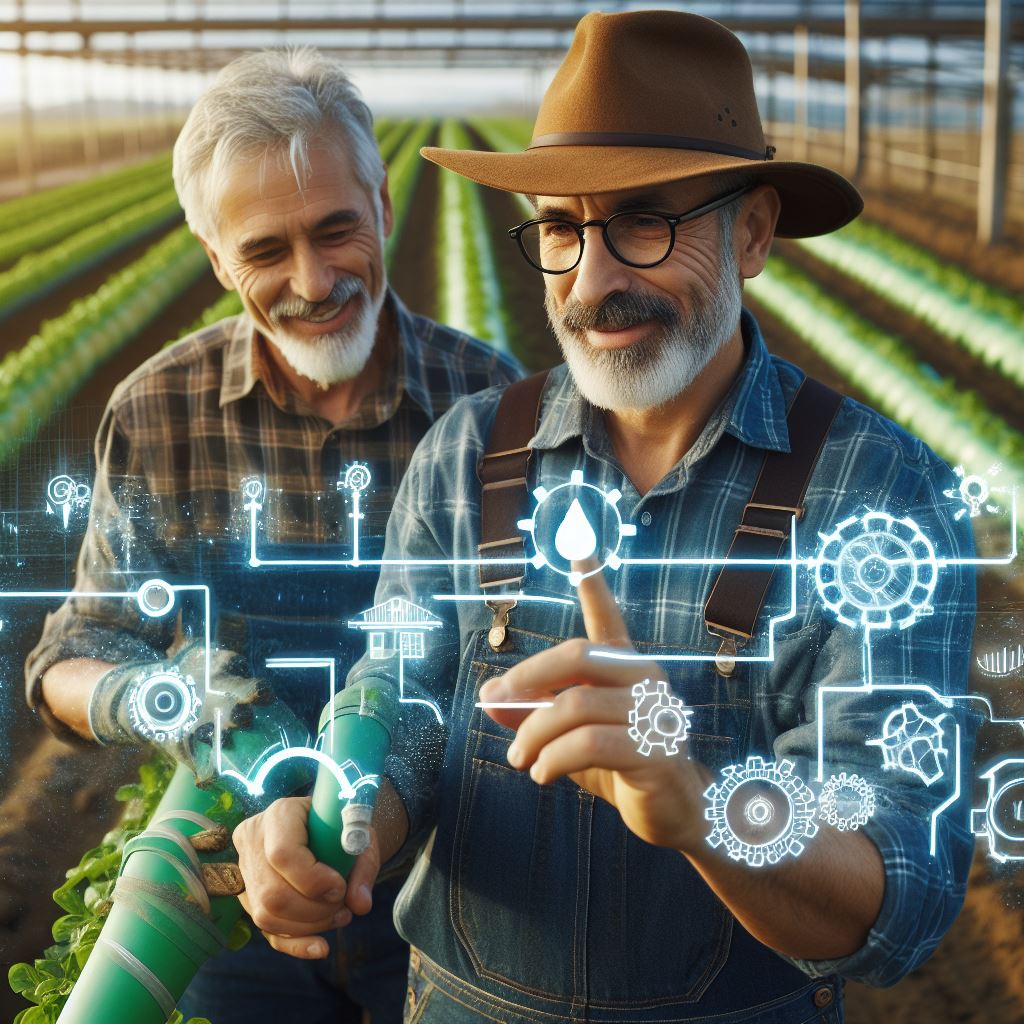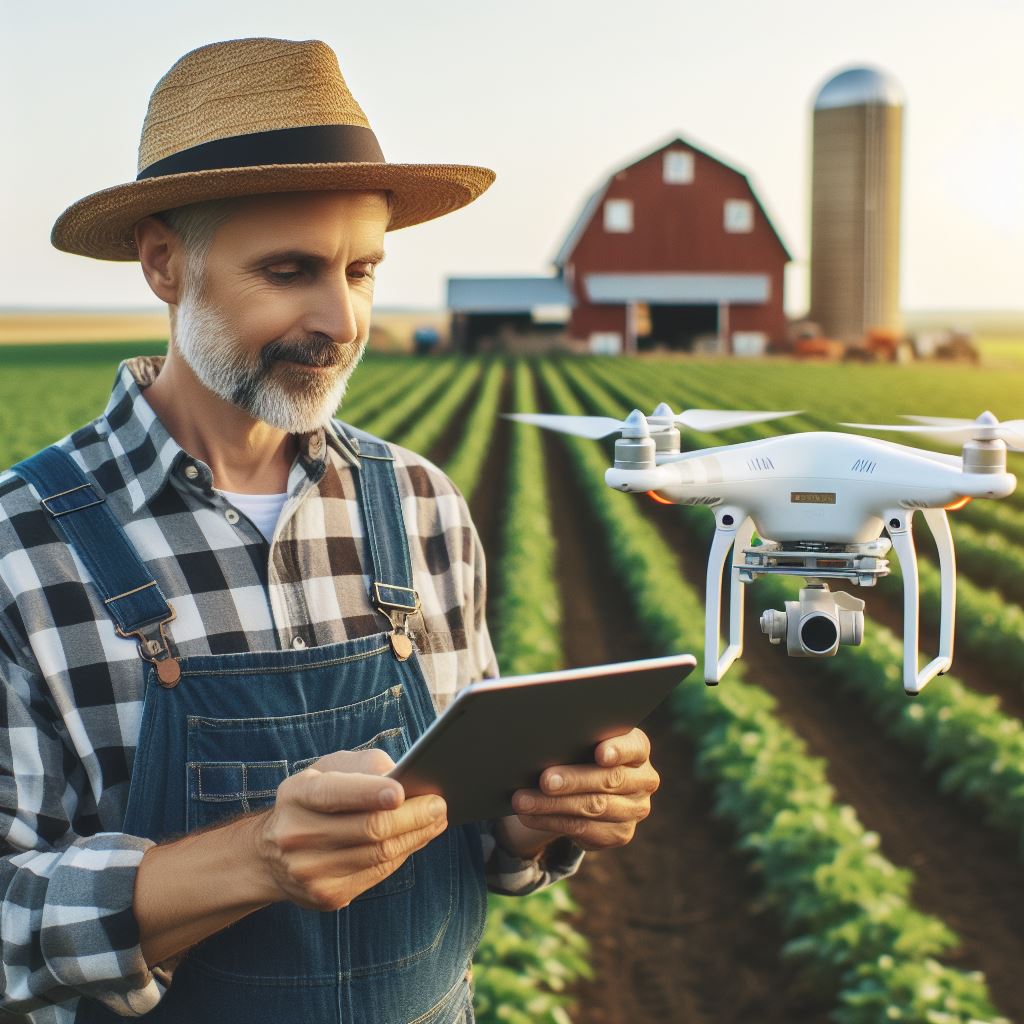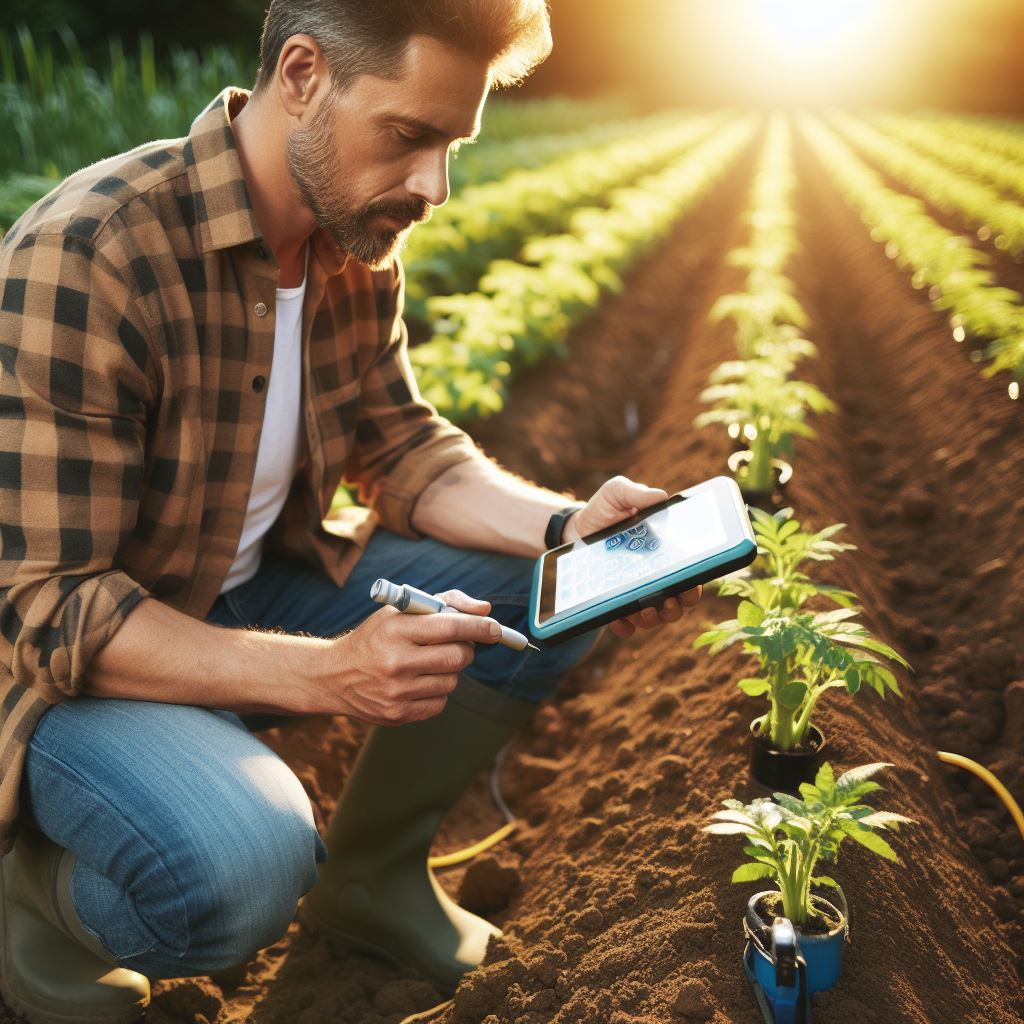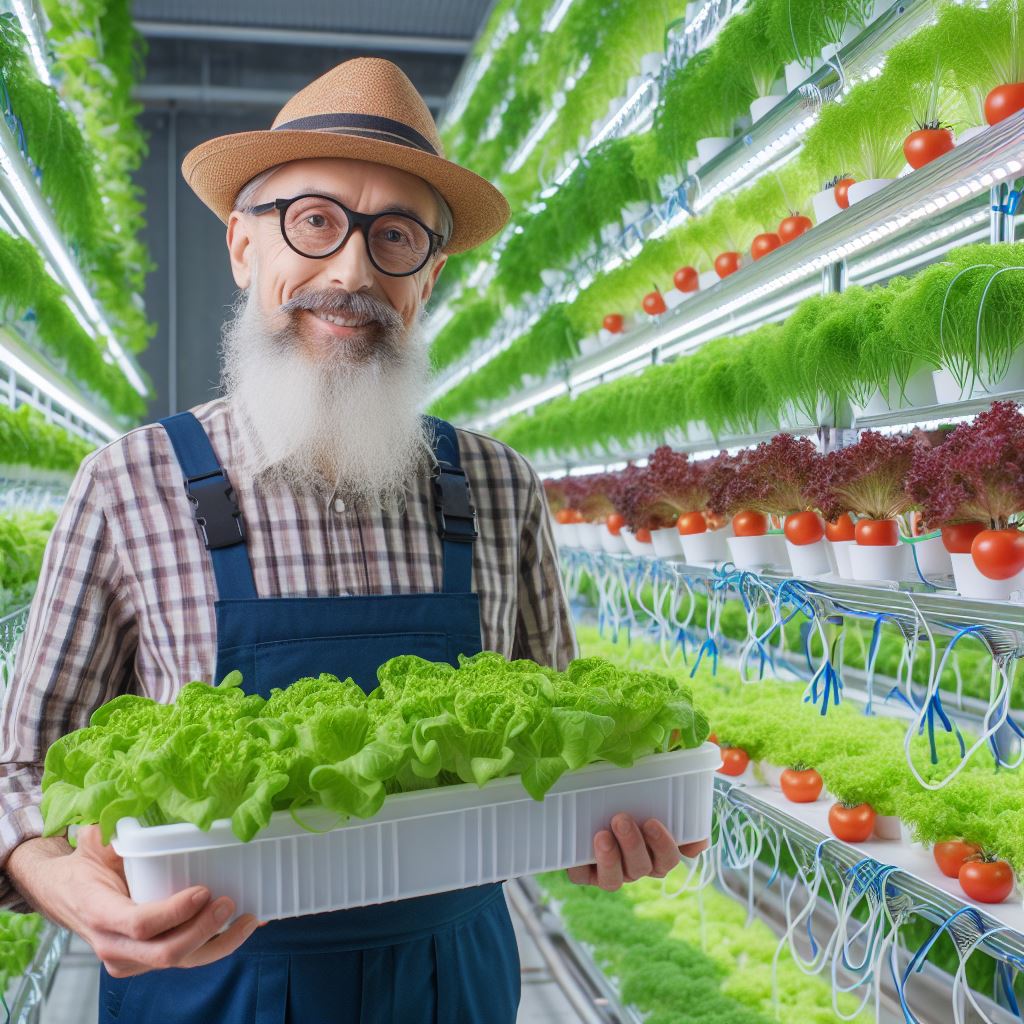Introduction
Importance of water conservation in farming
Agriculture consumes a significant amount of water, making water conservation in farming essential.
Farmers strive to find innovative solutions to minimize water usage and address water scarcity.
Innovative methods being used in water conservation
One method involves precision agriculture, using technology to optimize irrigation and minimize water waste.
Smart irrigation systems use sensors to measure soil moisture and only water crops when necessary.
Another innovation is the use of drought-resistant crops that require less water for cultivation.
These crops are genetically modified to be more efficient in water usage, minimizing water requirements.
Conservation tillage is another technique where crops are grown without disturbing the soil, reducing water runoff.
This method helps retain moisture, improving the water-holding capacity of the soil.
Cover crops play a vital role in reducing water consumption by creating a protective cover for the soil.
They prevent evaporation and erosion, ensuring water availability for the main crops.
Furthermore, farmers are adopting water recycling and reusing techniques, reducing dependence on freshwater sources.
Advanced farming practices like hydroponics and aeroponics utilize water efficiently by providing plants with only necessary amounts.
Basically, water conservation is vital in farming, and innovative methods are being embraced to achieve sustainable agriculture.
These advancements not only conserve water but also increase crop productivity and reduce environmental impact.
Traditional Water Conservation Techniques in Farming
Traditional irrigation methods
- Flood Irrigation: Utilizes gravity to distribute water through canals or ditches, flooding the entire field.
- Furrow Irrigation: Water is distributed through furrows or channels between crop rows.
- Sprinkler Irrigation: Water is sprayed onto fields through sprinklers, resembling rainfall.
- Drip Irrigation: Water is directly delivered to plant roots through a network of tubes, minimizing water loss.
Challenges and limitations of traditional techniques
- Inefficient Water Use: Flood and furrow irrigation methods often lead to high evaporation and surface runoff, wasting water.
- Inconsistent Water Distribution: Traditional methods may result in uneven water distribution, causing dry or overwatered areas.
- High Energy Consumption: Sprinkler systems require significant energy to pump and distribute water.
- Limited Precision: Traditional techniques lack precise control over water application, leading to overuse or inadequate irrigation.
- Soil Erosion: Flood irrigation can cause soil erosion and nutrient loss, impacting long-term soil health.
- Weed and Disease Spread: Overhead sprinklers can promote weed growth and disease spread due to increased moisture.
- Water Contamination: Excess water and chemicals used in traditional techniques can contaminate groundwater and nearby water bodies.
- Labor and Maintenance Intensive: Traditional systems often require manual labor for operation and maintenance.
Traditional water conservation techniques
As farming practices evolve, traditional water conservation techniques face increasing scrutiny due to their limitations.
Transform Your Agribusiness
Unlock your farm's potential with expert advice tailored to your needs. Get actionable steps that drive real results.
Get StartedThese methods have been used for centuries, but their inefficiency and negative environmental impacts call for innovation and adoption of alternative approaches.
Traditional irrigation methods, such as flood irrigation, rely on gravity to distribute water throughout a field.
Water is poured into canals or ditches and floods the entire area.
While this technique is simple and inexpensive, it results in significant water loss due to evaporation and surface runoff.
Additionally, it lacks precision, often leading to overwatering in some areas and underwatering in others.
Furrow irrigation
Furrow irrigation involves creating channels or furrows between crop rows, allowing water to flow directly to the plants’ roots.
Although it minimizes evaporation compared to flood irrigation, it still suffers from uneven water distribution and potential water wastage.
Sprinkler irrigation
Sprinkler irrigation mimics rainfall by spraying water onto fields through sprinklers.
While it provides more precise water control compared to flood and furrow irrigation, it consumes substantial energy and can promote weed growth and diseases.
Drip irrigation
Drip irrigation is a more efficient method where water is directly delivered to the plants’ roots through a network of tubes.
This technique minimizes evaporation and ensures uniform water distribution, reducing water wastage significantly.
However, the initial installation cost of drip irrigation systems can be higher compared to traditional methods.
Despite their historical significance, traditional techniques present several challenges and limitations.
Inefficient water use, inconsistent water distribution, high energy consumption, limited precision, soil erosion, weed and disease spread, water contamination, and labor-intensive maintenance are prominent issues.
Innovative water conservation methods
Therefore, farmers and researchers have been actively exploring innovative water conservation methods.
These techniques aim to optimize water use, improve water distribution precision, reduce energy consumption, mitigate environmental impact, and enhance crop yield.
Precision irrigation systems
Some innovative approaches include precision irrigation systems equipped with sensors to monitor soil moisture levels.
These systems can assess the water requirements of crops more accurately and deliver water accordingly, minimizing water wastage and reducing energy consumption.
Smart irrigation technologies
Furthermore, smart irrigation technologies utilizing weather data and artificial intelligence can dynamically adjust irrigation schedules based on specific crop needs and weather conditions.
This allows for more precise water application and reduces the risk of overwatering or underwatering.
Use of soil moisture sensors and automated drip irrigation systems
Another advancement is the use of soil moisture sensors and automated drip irrigation systems.
These sensors measure soil moisture levels, triggering the irrigation system only when necessary.
This approach optimizes water distribution, minimizes water loss, and improves overall crop health.
In general, traditional water conservation techniques in farming have served humanity for centuries but come with inherent challenges and limitations.
Showcase Your Farming Business
Publish your professional farming services profile on our blog for a one-time fee of $200 and reach a dedicated audience of farmers and agribusiness owners.
Publish Your ProfileAs the need for sustainable agriculture grows, innovative approaches are being developed to overcome these drawbacks.
By adopting modern irrigation technologies, farmers can optimize water use, improve crop productivity, and protect the environment for future generations.
Read: Water Wisdom: Soil Moisture Management
Innovative Water Conservation Techniques in Farming
Introduction of Drip Irrigation System
Drip irrigation is a system that delivers water directly to the roots of plants.
This technique reduces water loss due to evaporation and ensures efficient water usage.
Benefits of Drip Irrigation
Drip irrigation offers several benefits in terms of water conservation in farming.
Firstly, it minimizes water wastage by delivering water precisely to the plant’s root zone.
Secondly, it reduces the chances of weed growth as it only waters the plants and not the surrounding areas, resulting in less competition for water resources.
Additionally, this system helps prevent nutrient leaching by controlling the water flow, resulting in better nutrient absorption by plants.
Moreover, drip irrigation allows farmers to apply fertilizers through the system, which enhances plant growth and minimizes nutrient loss.
Utilization of Soil Moisture Sensors
Soil moisture sensors are devices that measure the moisture content in the soil.
These sensors provide accurate data that helps farmers determine the irrigation needs of their crops.
Soil moisture sensors play a crucial role in efficient water use in farming.
The purpose of these sensors is to monitor soil moisture levels and provide real-time data to farmers.
By using this data, farmers can adjust their irrigation schedules according to the specific needs of the crops.
This ensures that plants are not over or under-irrigated, promoting healthy growth while conserving water resources.
Adoption of Precision Agriculture Technologies
Precision agriculture refers to the use of advanced technologies for optimized farming practices.
These technologies enable farmers to make informed decisions regarding water usage.
Precision agriculture techniques have revolutionized water conservation in farming.
By using tools such as GPS, drones, and remote sensing, farmers can accurately assess crop health and water requirements.
This helps them tailor irrigation schedules and application rates to match the specific needs of each crop, thereby minimizing water wastage.
Moreover, precision agriculture allows for the targeted application of fertilizers and pesticides, reducing their overall usage and minimizing the environmental impact.
Incorporation of Rainwater Harvesting Systems
Rainwater harvesting involves collecting and storing rainwater for later use.
Implementing rainwater harvesting systems can help farmers reduce their dependence on external water sources.
Rainwater harvesting is a practical solution for water conservation in farming.
By capturing rainwater from rooftops, fields, or reservoirs, farmers can ensure a constant water supply during dry periods.
This stored water can be used for irrigation, livestock, and other agricultural activities, reducing reliance on groundwater and surface water sources.
Farmers can implement rainwater harvesting through various methods such as building ponds, using rain barrels, or constructing underground storage tanks.
Innovative water conservation techniques in farming, such as drip irrigation, soil moisture sensors, precision agriculture technologies, and rainwater harvesting systems, offer significant advantages in sustainable water management.
By adopting these techniques, farmers can minimize water wastage, improve crop yields, and ensure the long-term viability of their agricultural practices, while also contributing to the preservation of water resources for future generations.
Read: Automated Watering Systems: A Game Changer

You Might Also Like: AI in Farms: Precision Agriculture’s Rise
Success Stories of Innovative Water Conservation Methods
Example of a farm utilizing drip irrigation system
- Overview of the farm’s water conservation achievements: One successful example of innovative water conservation in farming is the implementation of a drip irrigation system by XYZ Farm. This system has greatly reduced water usage and improved overall water management on the farm.
- Challenges faced and lessons learned: XYZ Farm initially faced challenges in adapting to the drip irrigation system. They had to educate their workers on the proper usage and maintenance of the system, and overcome resistance to change. However, through perseverance and continuous learning, they managed to fully embrace the new technology.
Case study of a farm implementing precision agriculture technologies
Description of the farm’s improved water management practices
Another inspiring success story comes from ABC Farm.
This farm has implemented precision agriculture technologies to optimize water usage and minimize wastage.
Through the use of sensors, drones, and advanced data analytics, they can monitor soil moisture levels and adjust irrigation accordingly.
Impact of precision agriculture on the farm’s productivity and sustainability
The adoption of precision agriculture has significantly improved the productivity and sustainability of ABC Farm.
By precisely targeting water application, they have witnessed higher crop yields and reduced water runoff.
Additionally, the farm’s overall water consumption decreased, leading to cost savings and a smaller environmental footprint.
Overall, these success stories demonstrate the potential of innovative water conservation methods in farming.
By embracing technologies like drip irrigation and precision agriculture, farms can achieve significant water savings while also improving productivity and sustainability.
Showcase Your Farming Business
Publish your professional farming services profile on our blog for a one-time fee of $200 and reach a dedicated audience of farmers and agribusiness owners.
Publish Your ProfileChallenges that come with the implementation of these methods
It is important for farmers to understand that implementing such methods may come with challenges.
Proper training and education are crucial to ensure successful adoption and usage of these technologies.
Additionally, farmers should be open to learning from their experiences and continuously look for ways to improve their water conservation practices.
In essence, innovative water conservation methods have the potential to revolutionize farming practices.
The success stories of XYZ Farm and ABC Farm highlight how drip irrigation and precision agriculture technologies can lead to significant water savings and improved productivity.
By adopting these methods and learning from their experiences, farmers can contribute to a more sustainable and water-efficient agricultural sector.
By actively embracing change and investing in innovative water conservation methods, farmers can play a crucial role in ensuring the responsible use of water resources for future generations.
Let us continue to celebrate and share these success stories as inspiration for others in the farming community to adopt similar practices.
Together, we can make a significant impact on water conservation in agriculture.
Read: Aquaponics in Farming: A Sustainable Water Solution
Explore Further: Breakthroughs in Soil Health: Agri-Tech’s Role
Future Prospects and Challenges in Innovative Water Conservation
Identification of potential advancements in water conservation
- New irrigation technologies that enhance water efficiency and minimize wastage.
- Development of drought-resistant crop varieties to reduce water requirements in farming.
- Application of precision farming techniques to optimize water usage and increase productivity.
- Integration of data-driven decision-making tools for efficient water management and conservation.
- Exploration of alternative water sources such as treated wastewater and rainwater harvesting.
Obstacles in adopting innovative techniques on a larger scale
- Limited awareness and knowledge among farmers about available water conservation technologies.
- High initial investment costs for implementing innovative water conservation measures.
- Resistance to change and reluctance to adopt new farming practices.
- Inadequate infrastructure for collecting, storing, and distributing alternative water sources.
- Poor policy support and lack of incentives for farmers to adopt innovative water conservation methods.
- Challenges in integrating different water conservation technologies and practices into existing farming systems.
- Limited access to training and education on innovative water conservation techniques.
- Dependence on traditional water management practices and lack of understanding about their inefficiencies.
In a nutshell, the future prospects of innovative water conservation in farming hold great potential for addressing the global water scarcity challenge.
Advancements in technology and the adoption of sustainable practices can significantly improve water use efficiency in agriculture.
However, several challenges need to be overcome, including limited awareness, high costs, resistance to change, and inadequate support systems.
Collaboration among farmers, researchers, policymakers, and industry stakeholders is crucial to overcome these obstacles and promote the widespread adoption of innovative water conservation techniques.
By implementing these advancements and addressing the challenges, farming can become more sustainable, resilient, and less dependent on diminishing water resources.
Read: Climate-Smart Agriculture: Water Conservation Tactics
Explore Further: Greenhouse Tech: Future of Controlled Agri
Conclusion
Recap of the importance of innovative water conservation in farming
Innovative water conservation methods play a crucial role in ensuring sustainable agriculture.
With growing water scarcity, these methods offer effective solutions for farmers.
By adopting innovative techniques such as drip irrigation, precision farming, and water-efficient crop varieties, farmers can reduce water wastage and increase productivity.
Conserving water in farming not only helps in preserving this precious resource, but it also contributes to the overall agricultural development and ensures food security.
Final thoughts on the potential of these methods to address water scarcity in agriculture
As water scarcity becomes a global concern, innovative water conservation methods provide hope for the future of agriculture.
These methods hold significant potential to address water scarcity challenges faced by farmers and mitigate the risks associated with climate change.
With ongoing advancements in technology and increasing awareness, the adoption of innovative water conservation methods in farming is expected to grow rapidly.
However, to fully realize their potential, it is crucial to promote these methods through education, policy support, and access to financial resources.
By investing in innovative water conservation practices, we can create a sustainable future for farming and ensure the availability of water for generations to come.




